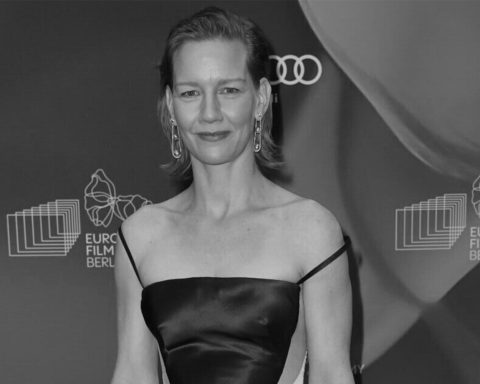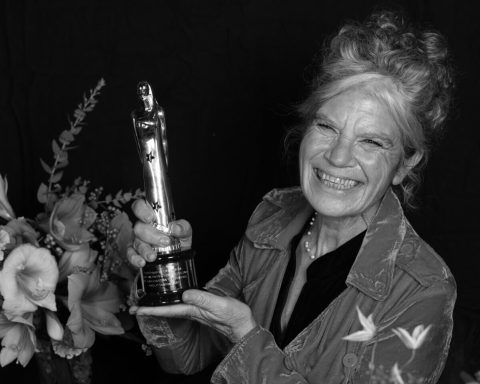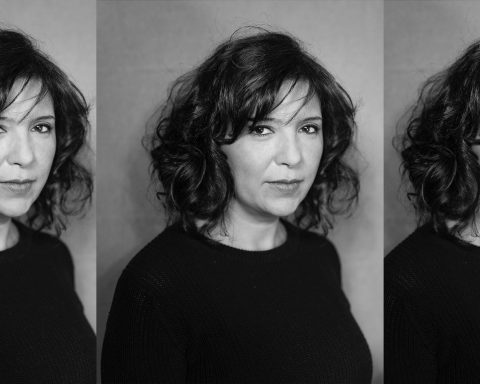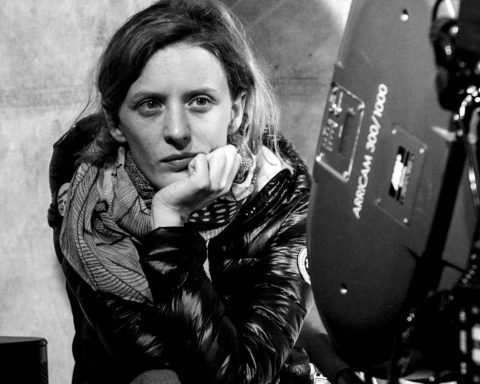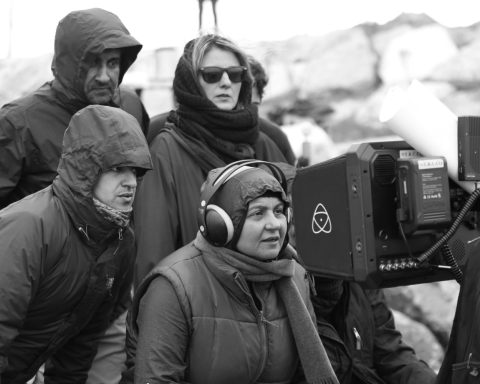Oana Păunescu started her film career in the 1980s and founded Castel Film, one of the largest Romanian production houses, in 1992, together with Vlad Păunescu. As film production in Romania took off, she began collaborating with foreign directors who came to shoot on location in Romania, designing costumes for characters inhabited by the likes of Elizabeth Hurley, Nicole Kidman, Wesley Snipes, Jude Law, or Jean-Claude Van Damme. She received two Gopo Awards nominations: one in 2009 for her costumes for Horaţiu Mălăele’s “Nunta Mută/ Silent Wedding” and one in 2015 for Dan Piţa’s “Kira Kiralina.” Cristi Puiu’s “Malmkrog” is her most recent Romanian project. Between 31 May and 8 June, Păunescu’s designs were exhibited at the Cluj Art Museum in the EPICexhibition, a symbolic journey generated by thousands of hours of work used as an escape into an unreal dream world. In 2017, she worked on the sci-fi thriller “What Happened to Monday” directed by Tommy Wirkola and starring Noomi Rapace, Glenn Close, and Willem Dafoe. One of the most prolific costume designers in Romania, she received a Lifetime Achievement Award at this year’s Transilvania International Film Festival where Tara Karajica caught up with her.
Have you always known you wanted to be a costume designer? How did you become one?
Oana Păunescu: Not really… In a way, it was incidental. As a kid, I loved to design and my parents who were doctors were very conservative. I was born in and lived my first childhood years under Communism and they thought that design was not a career and that I better study Economics or something that would broaden my horizons and that would enable me to travel. But because I was always sketching, sketching and sketching, my Maths teacher told my mother I should see a design teacher and I was very lucky because I met one who was famous: Nikolaj Aleksi. For me, the most important thing was to do industrial design, which was what I liked, but he said he thought I was more prepared for scene design. So I went to the Arts School and, actually there, I met a teacher, Andrej Bot, who introduced me to the universe of theater. I liked going to the theater, but I never thought that I would end up working there. After graduation, I’ve worked in Romanian theater for two years, and then I got into the Buftea Studio, a major studio in Romania, and there by chance, the director asked me if I wanted to sign the costumes for my first film. It was really a hard one, Domnisoara Aurica by Serban Marinescu and it was very well received; I was awarded a Prize by the Romanian Filmmakers Union and received all sorts of awards, and from then on, it went really smoothly for another three years until the ‘90s, when the revolution began.
You had your big international break when foreign productions came to shoot in Romania. Can you talk about this experience and that change in your career?
O.P.: Yes! It changed my career and in a way it was also a big change for all of us. The ‘90s and the period after the revolution were tough times for everybody working in the film industry. The first Americans arrived in Romania, looking for new places where to shoot. At that time, Yugoslavia was in the middle of the war, so they came here with a vampire film, looking for people to sign the key positions. I was presented by the Romanians who were in charge of Buftea and they said: “Maybe she’s good for what you need” and so it was the first film that I did and I worked with my husband, Vlad Păunescu – he was the cinematographer and I was the costume designer. That film was an American production, a small budget one that was supposed to be shot in one month, but because of Romania and our lack of skills – we didn’t know anything about productions the American way – it lasted longer. So, after a year and after we wrapped the production, we got a phone call from an American company asking if we wanted to open a Romanian-American company and get involved in film productions. It wasn’t something I thought about; it was something that life put on my path. We opened a studio in 1992, Castel Film, a Romanian studio, and we put together the crew and everything else and I worked as costume designer. That was how things happened and then, step by step, I didn’t have time to work for Romanian productions anymore. But Romania was nothing in terms of Film back then because there was a collapse in the film industry and Castel Film was an opportunity for us to have a job.
You did work for Romanian productions afterwards…
O.P.: I started working on Romanian productions in 2008 with Horaţiu Mălăele and his film Silent Wedding. That was my first comeback in Romanian film and since then, I have worked on Romanian productions because I really enjoy them; they belong to a different sort of films.
So what is the difference between the American and Romanian films in terms of costume design and work dynamics in that department?
O.P.: I feel like I am on holiday when I am working for Romanian productions because in the American ones, it’s quite stressful, there is a lot of pressure and they are a sort of industry of its own. The Romanian film industry is still sort of a family and, of course, being a native, you know the actors and some of the actors were there when I first started out, so I really enjoy working on Romanian films. Now, it’s an industry. I think it’s more auteur compared to the American ones that are more commercials and more money-oriented.
How is costume design in Romanian Cinema now?
O.P.: It’s getting better and I am not modest; I can say that I helped a bit. There are a lot of young people who have worked with me and others who have worked in the American system and brought what they learnt there to the Romanian film industry where they are working now with big success. There are some names who have really changed Romanian films in terms of costume design and I really hope it all improves even more.
What triggers your creativity? How do you get in the zone and what is your work process?
O.P.: It depends. The work process is that I read the script and I have a discussion with the director and I find out what he wants and where he wants to go with his project. I start documenting and that’s the nicest part of the process because then, I surf on the Internet and read many History books. If it’s a period film, I read about how people lived and I find out about that and I feel like a historian or an anthropologist trying to learn about not necessarily the cut of the costume, but more about how people lived, where they slept, how they ate, what pleased them and things like that.
In your opinion, how does a costume help the filmmaker tell his story and complete a character and make it stand out?
O.P.: From my point of view, it’s even more important than the production design. I feel that clothes are crucial in helping actors get into a role. What we do in costuming brings the salt and pepper to the character. There are so many actors who are pleased with the wardrobe and you can see that as soon as they slip into their costumes, they are even more creative and the wardrobe makes them feel like they are the character. If they are not at ease, I think you can sometimes feel it and see it on the screen. I think costume is very important. It’s like the second skin.
There has been a lot of talk about women in film recently. What is your position on the situation and how is it in the costume design world?
O.P.: I think I worked with a female director years ago, at the beginning of my career. But since then, I have only worked with men. For me, I don’t have an issue or a problem; I don’t see a difference. If it’s a director who knows what he/she wants, you have to be on the same page – it’s also about chemistry, it’s not only about talent because I think in Art and wherever there is emotion, you have to have a discussion with the person you work with.
Who is your favorite female filmmaker and who would you like to work with?
O.P.: Sofia Coppola. I like her and I like what she did and how daring she was with Marie Antoinette. I think she was one of the first ones who realized that for young people you don’t have to do a replica of the period, but something that is appealing in terms of fashion and spin it to fit the modern times. Or Cristina Jacob – I appreciate her work very much because she dares to do an easy film, but one that young people need.
Is there someone who inspires you in the costume design world?
O.P.: Yes. I worked on Cold Mountain with Anne Roth and, for me, it was a source of endless inspiration. I think I can speak about my career before and after meeting Anne Roth. I really appreciate Milena Canonero as well. I have also worked with another exquisite costume designer – his name is Pierre-Yves Gayraud. They are all geniuses. Wherever you may be in your career, you can always hope that one day you’ll be compared to them.
What film are you most proud of that you worked on?
O.P.: I am proud of the last film I worked on, Malmkrog, which was directed by Cristi Puiu,
What are you working on next?
O.P.: Right now, I am working with a director called Josif Demian who came back to Romania after thirty years in Australia and he is making a very interesting film I stepped in because I liked the script very much. In the future, there is another American film with Tommy Wirkola that is being pushed a little bit. But the project that I am sure I will do is with my husband, a very challenging project about the miners who came to Romania; a very poetic script about a very well-known actor who became a monk.
This interview was conducted at the 2019 Transilvania International Film Festival.





